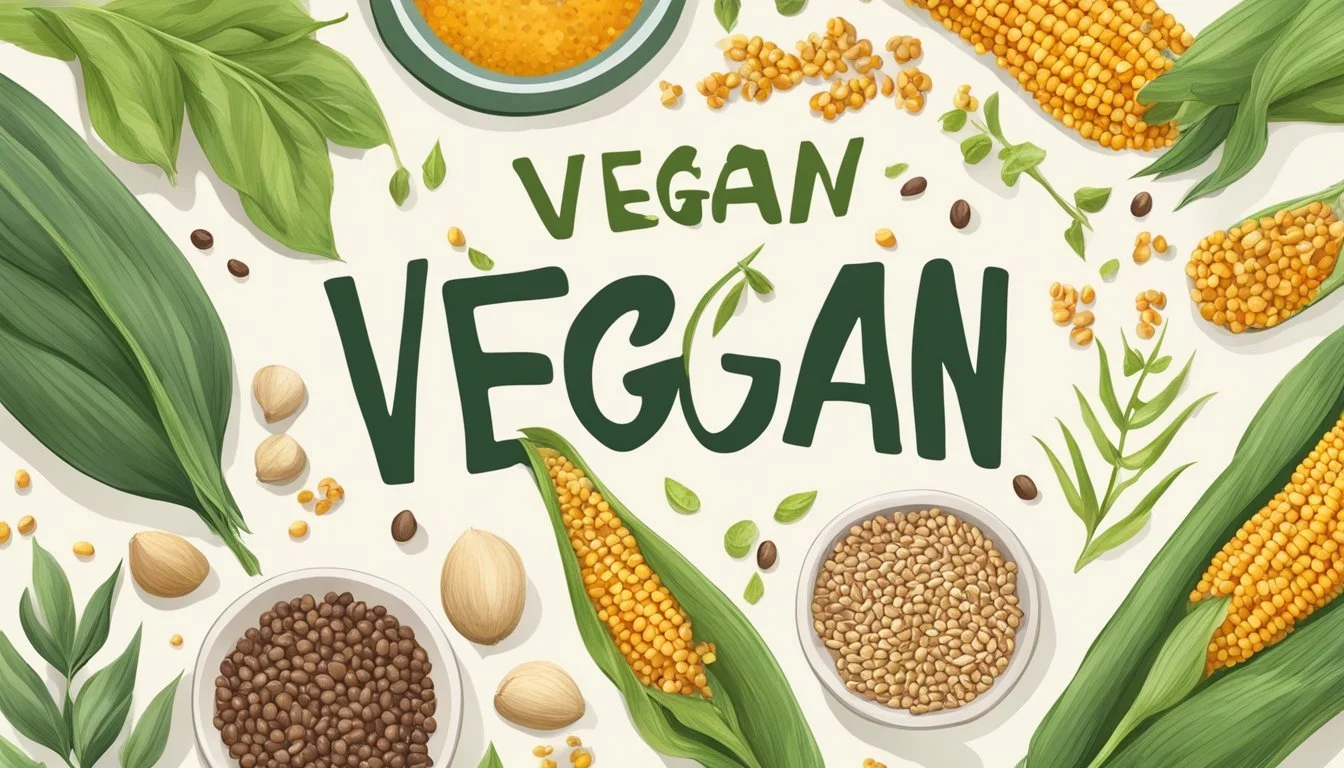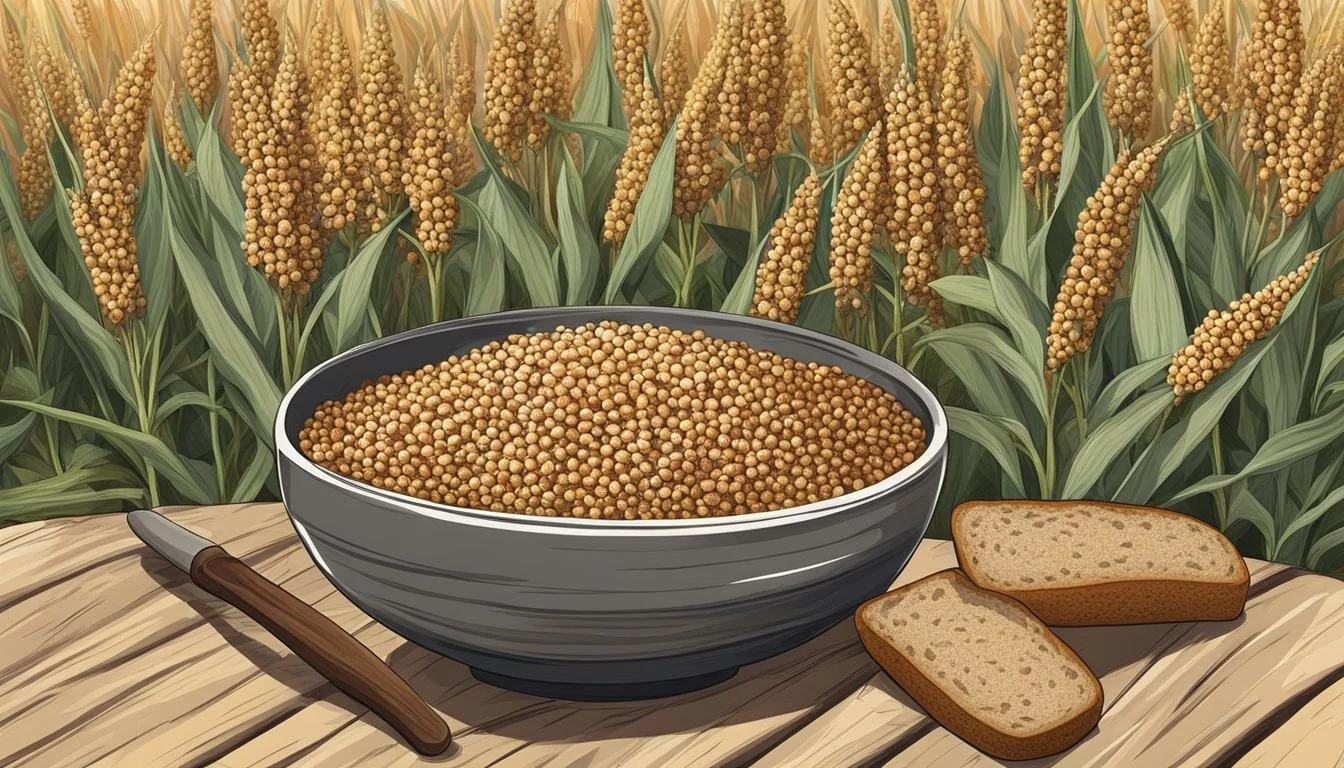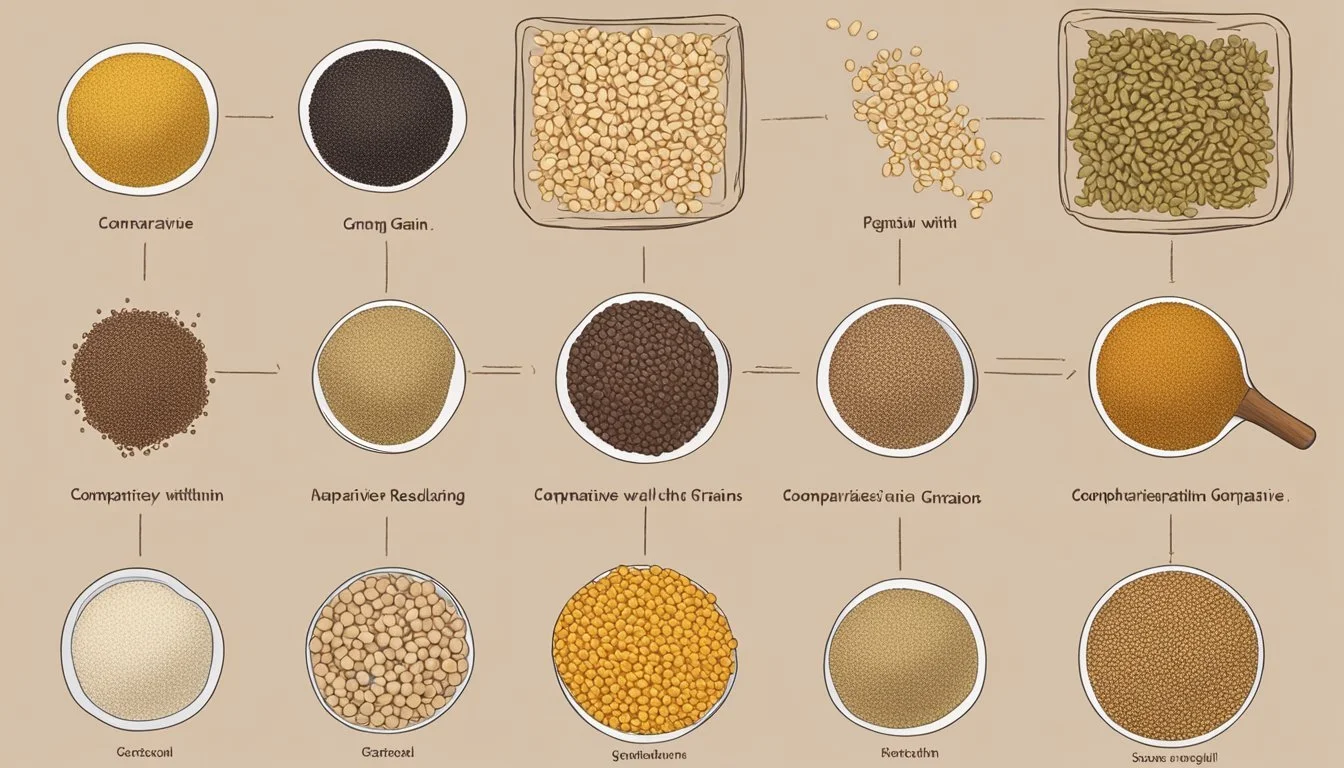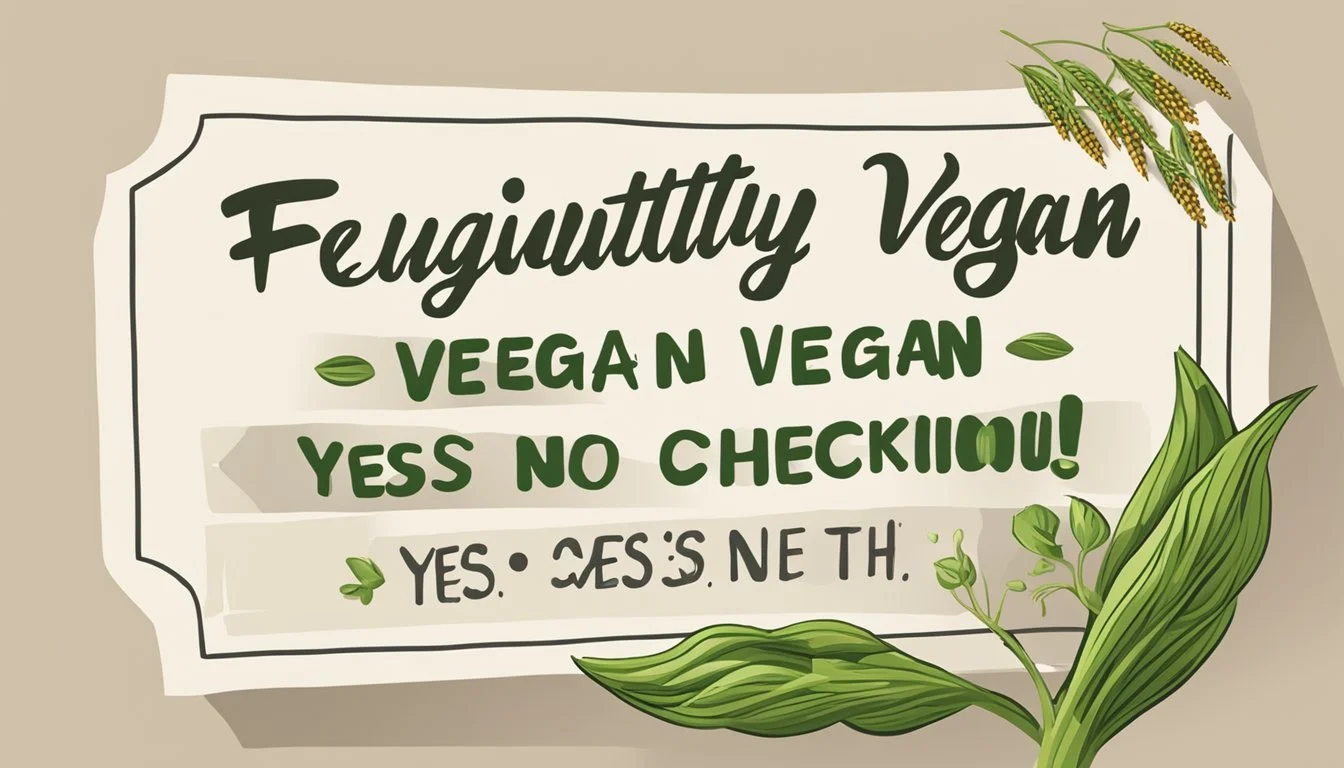Is Sorghum Vegan?
Understanding Plant-Based Food Options
Sorghum is a nutritious grain that is well-suited for vegan diets. As a plant-based food, it naturally aligns with vegan principles, which avoid animal products for ethical, health, or environmental reasons. This versatile crop, a member of the grass family, is celebrated for its resilience to drought and its ability to thrive in a variety of climates, making it a reliable staple for many cultures around the world.
From a nutritional standpoint, sorghum is rich in essential nutrients that contribute to a balanced vegan diet. It is an excellent source of protein, fiber, and minerals such as iron and phosphorus, while also being inherently gluten-free. Easy to prepare and adaptable in many recipes, sorghum can be enjoyed as a whole grain, ground into flour for baked goods, or even popped like popcorn.
The inclusion of sorghum in vegan diets is not just beneficial for its nutritional profile, but also for its environmental sustainability. Its natural resistance to drought conditions means it typically requires less water to grow compared to other crops, thereby conserving valuable resources. This aspect is particularly appealing to those who adopt veganism out of environmental consciousness, making sorghum an excellent fit for sustainable plant-based eating.
What Is Sorghum?
Sorghum is an ancient grain, considered one of the five top cereal grains in the world. It stands alongside wheat, maize, rice, and barley, but distinguishes itself with several unique characteristics.
Origin and Classification
Taxonomy: Sorghum belongs to the Poaceae family and is a grass species.
Ancient Roots: It has a history dating back millennia and has been a staple in various cultures.
Dietary Benefits
Gluten-Free: Naturally gluten-free, sorghum is a suitable option for people with celiac disease or gluten sensitivities.
Whole Grain: As a whole grain, it provides essential nutrients and is a good source of fiber.
Cultivation and Resilience
Drought Resistance: Thrives in arid climates, making it an important crop in areas with water scarcity.
Versatility: It can be popped like popcorn, turned into syrup, or ground into flour.
Nutritional Profile
Plant-Based Nutrition: Sorghum is rich in plant-based protein and iron, aligning well with vegan and vegetarian diets.
Mineral Rich: Contains minerals such as magnesium, potassium, and zinc.
Sorghum's role as a food source is diverse. It can be consumed as a grain, made into flour for baking, or even used to sweeten foods in the form of syrup. Its adaptability to various soil types and climates, combined with its nutrient density, underscores sorghum's value in global agriculture and diets.
Nutritional Profile of Sorghum
Sorghum is a nutrient-dense grain known for its impressive contribution to a balanced diet. This grain is particularly important as a dietary staple in various parts of the world and serves as an excellent source of both macronutrients and micronutrients.
Macronutrients in Sorghum
Sorghum is a rich source of macronutrients, which are essential for providing the body with energy and supporting overall health. This grain contains a significant amount of dietary fiber and protein, two key components that contribute to feelings of fullness and muscle maintenance. With its high fiber content, sorghum can aid in improving gut health. Additionally, sorghum's protein is valuable for those adhering to a vegan diet, offering an alternative plant-based protein source.
Dietary Fiber: Sorghum's fiber content supports digestive health.
Protein: It provides plant-based protein that is crucial for body repair and growth.
Micronutrients in Sorghum
The micronutrients found in sorghum include a variety of vitamins and minerals that are vital for many bodily functions. It is particularly rich in iron and magnesium, minerals that play a significant role in maintaining healthy blood and bones, respectively. Moreover, sorghum contains beneficial antioxidants, which can help protect against cellular damage.
Iron: Important for oxygen transport and energy production.
Magnesium: Supports bone health and enzymatic reactions.
Antioxidants: Help in combating oxidative stress.
Health Benefits of Sorghum
Consuming sorghum may have several health benefits due to its rich nutritional makeup. Its fiber content may contribute to lowering blood pressure and improving heart health. The antioxidants in sorghum may further bolster heart health by preventing oxidative damage to cardiovascular tissues. Furthermore, the inclusion of sorghum in one's diet can provide essential nutrients that are important for maintaining good health, overall.
Blood Pressure: Fiber and other components in sorghum may help to manage blood pressure.
Heart Health: Antioxidants and fiber both contribute to cardiovascular well-being.
Sorghum in the Vegan Diet
Sorghum is an integral part of a vegan diet due to its versatility and nutritional profile. This gluten-free grain serves as an excellent plant-based choice for people adhering to various dietary restrictions.
Is Sorghum Naturally Vegan?
Sorghum is naturally vegan, as it is a cereal grain that does not involve any animal products or by-products in its cultivation or processing. It is completely plant-based and fits easily into diets that are dairy-free, egg-free, and nut-free. Rich in nutrients and recognized as a staple food in many regions, sorghum is ideal for those seeking sustainable vegan dietary options. Due to its composition, it is not only vegan but also a good choice for people with gluten intolerance or those who follow a gluten-free diet.
Vegan Cooking and Baking with Sorghum
In vegan cooking, sorghum can be found in various forms:
Whole Grain: Ideal for pilafs or as a base for bowls
Flour: Used in gluten-free baking
Syrup: Acts as a sweetener
Here's how sorghum can be utilized in vegan cooking and baking:
Whole Sorghum Grains: Can be cooked and used in salads, buddha bowls, or as a rice substitute. Cook them in water with a pinch of salt, simmering for 50-60 minutes or 15 minutes in a pressure cooker until tender.
Sorghum Flour: Perfect for vegan, gluten-free bread, pancakes, and other baked goods. It helps create a soft texture and is often blended with other gluten-free flours.
Sorghum Syrup: Acts as a plant-based sweetener in baked treats or breakfast dishes, enhancing flavors without using animal-derived products.
Gluten-Free Benefits of Sorghum
Sorghum flourishes as a gluten-free alternative, evident through numerous studies that showcase its positive role for individuals with celiac disease and gluten sensitivity. It not only bypasses the gluten predicament but also brings forth a bevy of health advantages.
Sorghum for Celiac and Gluten Sensitivity
Celiac Disease: Those diagnosed with celiac disease must adhere to a strict gluten-free diet as it's imperative for their health. Sorghum stands out as a safe staple, devoid of the proteins that trigger adverse reactions in these individuals. Its natural absence of gluten is a beacon of hope for those seeking nutritional security without the risks.
Gluten Sensitivity: Similar to celiac sufferers, people with non-celiac gluten sensitivity experience negative symptoms from ingesting gluten. Sorghum serves as a cornerstone in their diet, providing a versatile and worry-free alternative to traditional gluten-containing grains.
Moreover, sorghum's diverse culinary potential allows it to replace wheat flour in various recipes without the need for xanthan gum, a common ingredient added to gluten-free recipes for texture but can be an allergen for some. This positions sorghum as a particularly advantageous option within the gluten-free and xanthan gum-free communities, ensuring everyone has the opportunity to enjoy a broad range of foods.
Sorghum Varieties and Uses
Sorghum, a versatile grain embraced in various forms, offers a plethora of uses in vegan cooking and baking. It stands as a staple ingredient in a myriad of dishes globally, ranging from savory to sweet applications.
Different Forms of Sorghum
Sorghum comes in multiple forms, with sorghum grains and sorghum flour being most prominent in the culinary world. Sorghum grains are known for their hearty, chewy texture and are often used as a nutritious alternative to other grains. Sorghum flour, which is derived from the milling of sorghum grains, is a gluten-free option favored in baking for its light texture and mild flavor. It's commonly utilized in creating sorghum sourdough bread, providing a nuance in taste and healthiness not found with traditional wheat flours. Another delicious manifestation is sorghum popcorn, a popped version of the whole grain that offers a crunchy snack option.
Sorghum Grains
Cooking Method: Typically boiled in water with a pinch of salt.
Ideal Ratio: One cup of grains to three cups of water.
Texture: Chewy bite after 50-60 minutes of simmering.
Sorghum Flour
Usage: Excellent for gluten-free baking applications.
Qualities: Light texture and mild, slightly sweet flavor.
Baking Benefits: Often used in pantries for pancakes, bread, and cookies.
Sorghum in Recipes and Cooking
In the realm of vegan cooking, sorghum syrup also makes an appearance as a natural sweetener. It's a wholesome alternative to molasses or honey, fitting perfectly into the vegan diet. Sorghum plays a multifaceted role in recipes, easily incorporated into soups, stews, salads, and even chili, enhancing both the nutritional value and satiety of vegan dishes.
Cooking
Versatile Use: Stir into soups, stews or create a grain bowl.
Enhancement: Adds a nutritious boost to any meal.
Baking
Flour Form: Integral in gluten-free recipes.
Texture Contribution: Helps achieve a desirable crumb in baked goods.
Sweetener Form: Sorghum syrup adds moisture and sweetness to recipes.
With its adaptability in various forms and beneficial nutritional profile, sorghum is an excellent addition to the vegan pantry, worthy of exploration across an array of recipes.
Preparing Sorghum
When preparing sorghum, one should be aware of the various cooking methods that can be employed to achieve optimal taste and texture. Proper storage techniques are crucial to maintain freshness whether one is dealing with the grain or its flour.
Cooking Methods
Stovetop: To cook sorghum on the stovetop, one should bring water to a boil with a dash of salt, then add the sorghum grains. It's recommended to use a water-to-sorghum ratio of about three-to-one. Once added, the heat should be reduced to a low simmer and the grains should be left to cook for approximately 50 minutes, or until tender. Stir occasionally to prevent sticking.
Pressure Cooker: For those with less time, a pressure cooker offers a faster method. Combine rinsed sorghum grains with water and salt, using the same ratio as the stovetop method. Cook on high pressure for about 15 minutes, then allow the pressure to release naturally. This cuts the cooking time significantly while yielding a similar texture.
It's important to ensure the sorghum is fully cooked to become pleasant to eat, as it remains firm and chewy even when done.
Storing Sorghum
Fridge: Cooked sorghum grains should be cooled before storing. They can be kept in an airtight container in the fridge for up to a week, which allows for easy use in meals throughout the week.
Freezer: For longer storage, cooked sorghum can be frozen. One should spread the cooked grains on a baking sheet to freeze individually, and then transfer them to a freezer-safe bag or container. This prevents clumping and makes it easy to portion out the amount needed later. Frozen sorghum can last for up to 8 months.
Whether using a stovetop or a pressure cooker, preparing sorghum is a straightforward process. With proper storage, it can provide a nutritious and versatile base for a variety of vegan dishes.
Integrating Sorghum into Meals
Sorghum is a versatile grain that can easily be incorporated into various meals throughout the day. Its gluten-free nature and mild flavor make it suitable for a range of dishes, from breakfast to dessert.
Breakfast Options
For a hearty start to the day, sorghum can be utilized in breakfast bowls. Cooked sorghum grains add texture and nutrition to a morning meal, pairing well with fruits and non-dairy milk. Sorghum pancakes are another delightful option, offering a gluten-free alternative to traditional pancakes. One may enhance the flavor by incorporating banana or blueberries into the batter.
Lunch and Dinner Ideas
Sorghum serves as an excellent base for salads, providing a chewy contrast to crisp vegetables. In grain bowls, roasted veggies and beans complement the nuttiness of sorghum, creating a filling lunch or dinner. Sorghum can also be used in sourdough bread, offering a unique twist to sandwiches with its subtle sweetness and hearty texture. For those looking to explore, sorghum grains can be simmered and added to a sandwich as a wholesome filling, alongside fresh vegetables and spreads.
Snacks and Desserts
As a snack, sorghum can be popped like popcorn or mixed with nuts and seeds to make a nutritious trail mix. Savory roasted sorghum grains can also be seasoned and enjoyed as a crunchy snack. In desserts, sorghum flour can be the base for cookies or cakes, providing a rich, earthy flavor profile and a pleasing texture. For a sweeter treat, consider sorghum molasses as a natural sweetener in baked goods or as a syrup alternative for pancakes or waffles.
Customizing Sorghum for Taste and Health
When preparing sorghum, individuals can enhance its naturally nutty flavor and optimize its health benefits by selecting specific ingredients and cooking methods.
Flavor Enhancements for Sorghum
Adding olive oil, salt, and spices such as garlic powder can significantly elevate the taste of sorghum. To create a sweet profile, natural sweeteners like maple syrup can be used sparingly. As sorghum has a mild taste, it pairs well with a variety of flavors, from savory to sweet.
For a savory twist: Combine cooked sorghum with olive oil (drizzle), salt (pinch), and garlic powder (to taste).
For sweetness: Drizzle a small amount of maple syrup over sorghum or add a touch of sugar as a sweetener.
Making Sorghum a Healthy Choice
Sorghum is inherently a healthy grain, high in protein and fiber. To maintain its nutritional integrity, one should be mindful of the quantity and type of additions made during preparation.
Nutrition Facts of Interest:
Sorghum contains approximately 10 grams of protein and 6 grams of fiber per half a cup.
It's also a source of potassium, niacin, thiamin, vitamin B6, and minerals such as magnesium and manganese.
By using healthy oils like olive oil and natural sweeteners in moderation, one can enjoy the taste and health benefits of sorghum without compromising nutritional value.
Comparative Analysis With Other Grains
In this section, the dietetic and textural contrasts between sorghum and other prominent grains are scrutinized, providing a clear perspective on how sorghum aligns within a vegan diet in comparison to its counterparts.
Sorghum vs Other Gluten-Free Grains
Sorghum stands out in the gluten-free grain landscape for its chewy texture and hearty flavor. It bears a closer relation to millet in terms of gluten content but offers a more robust taste compared to millet's mild, nutty profile. On the other hand, quinoa and buckwheat provide distinctive alternatives:
Quinoa: Known for its high protein content and complete amino acid profile, quinoa exhibits a fluffy texture and slightly nutty flavor when cooked.
Buckwheat: Despite its name, buckwheat is gluten-free and presents a soft texture with an earthier taste.
Flours made from these grains, such as millet flour and buckwheat flour, offer similar gluten-free benefits, with varying degrees of flavor and texture suitable for various culinary uses.
Nutritional Comparison to Wheat and Rice
When comparing sorghum to wheat and rice, one observes differences in nutritional compositions.
Sorghum: Higher in antioxidants and fiber with a protein composition akin to that of wheat, while being gluten-free.
Wheat Flour: Generally higher in protein but contains gluten, which is unsuitable for those with celiac disease or gluten intolerance.
Rice: While rice brings to the table a versatile texture and neutral taste, it often falls short in fiber when compared to sorghum.
Rice Flour: Commonly used in gluten-free baking, though it lacks the fiber content found in sorghum.
Here’s a simplified comparison:
Grain/Flour Gluten Content Protein Fiber Taste and Texture Sorghum Gluten-free Moderate High Chewy; Hearty Millet Gluten-free Low Moderate Soft to Crunchy; Mild Quinoa Gluten-free High Moderate Fluffy; Slightly Nutty Buckwheat Gluten-free Moderate High Soft; Earthy Wheat Flour Contains Gluten High Low Varied; Mild Rice Flour Gluten-free Low Low Fine; Neutral
In summary, sorghum offers a nutritious and versatile gluten-free option, while flour variants such as millet and buckwheat flour allow for a range of textures and flavors fit for diverse culinary landscapes.
Potential Drawbacks of Sorghum
Sorghum is a versatile grain, often praised for its gluten-free and nutritional properties. However, even healthy foods like sorghum can have downsides, particularly when considering digestibility and its implications on a person's daily carbohydrate intake.
Digestive Considerations
Sorghum contains dietary fiber, which is beneficial for digestion, but its unique structure can make it more difficult for the body to absorb proteins from the whole grains. This might result in less efficient protein absorption compared to other grains. Moreover, the higher carbohydrate content of sorghum flour may be a concern for individuals who need to monitor their carbohydrate intake for health reasons, such as diabetes management. While fiber is essential for a healthy digestive system, the consumption of sorghum does need moderation, especially for those with digestive sensitivities or conditions that require careful dietary planning.
Sorghum's Global Impact
Sorghum is a vital crop serving as a cornerstone for food security and economic stability, particularly in regions like sub-Saharan Africa.
Sorghum Cultivation and Its Economic Role
Sorghum, an ancient grain originally domesticated in Africa, is now cultivated worldwide, particularly thriving in arid and semi-arid conditions where other grains might fail. Its natural resilience to drought and heat stress allows it to be an important crop for millions of people in Africa, offering a reliable source of nutrition and sustenance under increasingly challenging climatic conditions.
Economically, sorghum acts as a noteworthy contributor to the agricultural sector in many African countries. It supports livelihoods for smallholder farmers who rely on it not just for food but also as a source of income. Its adaptability to harsh environments positions it as a strategic crop to bolster economic activities in areas susceptible to climate variability. As a vegan and gluten-free grain, sorghum's market value is also enhancing, aligning with global dietary trends that seek sustainable and nutritious options.
Frequently Asked Questions
In this section, readers will find specific information on sorghum in the context of veganism and dietary considerations, addressing common inquiries and health-related aspects.
Common Queries About Sorghum
Is sorghum flour vegan? Yes, sorghum, known as jowar in some regions, is a plant-based ingredient and thus vegan. It is commonly used in gluten-free sourdough bread as a substitute for wheat flour.
Can sorghum flour be used in sourdough starters? Sorghum flour can be used to make a sourdough starter, which is a mixture of flour and water that captures wild yeast and bacteria. It is a gluten-free alternative for those who wish to make vegan sourdough bread.
Health and Dietary Concerns
What are the nutritional benefits of sorghum? Sorghum is high in nutrients including fiber, protein, and minerals. It is also low in calories, has no cholesterol, and is a good source of complex carbohydrates.
Nutrient Benefits Fiber Aids digestion and may regulate blood sugar Protein Crucial for muscle building and repair Complex Carbs Provides sustained energy
Can individuals with gluten intolerance eat sorghum? Yes, sorghum is naturally gluten-free and is suitable for those with celiac disease or gluten sensitivity. It can be used to make gluten-free sourdough bread with the addition of psyllium husk for binding, in place of gluten.
Conclusion
Sorghum flour and syrup are vegan-friendly options, suitable for those adhering to a plant-based diet. As a product derived from the grains of the sorghum plant, sorghum does not include any animal-derived ingredients.
The production of sorghum aligns with principles of sustainability, as it is a drought-tolerant crop, making it a favorable choice in arid regions and for those concerned with environmental impact.
This whole-grain boasts a range of nutritional benefits:
High in Fiber: Supports digestive health and may contribute to improved heart health.
Protein Content: Essential for muscle repair and growth.
Gluten-Free: Safe for individuals with gluten sensitivities or celiac disease.
Moreover, sorghum is considered a sustainable crop, with lower water and resource requirements compared to other grains. This aspect is particularly important for consumers who factor environmental impact into their dietary choices.
Incorporating sorghum into meals can be an effective way to enrich a diet with a nutrient-dense, versatile grain that also respects vegan principles.
References
When researching whether sorghum flour is vegan, several resources were consulted.
Online Articles: Articles from various culinary and dietary websites provided insights into sorghum flour and its compatibility with a vegan diet.
Food Blogs: These blogs offered practical recipes incorporating sorghum flour, showcasing its use in vegan cooking.
Notable Mentions:
100% Sorghum Flour Bread Recipe: This vegan and gluten-free recipe demonstrates the use of sorghum flour in baking without animal products.
Easy Sorghum Bread: Culinary instructions for a vegan sorghum bread recipe were provided, along with additional tips for yeast activation.
Sorghum Flour and Veganism: An article detailing the principles of veganism and how sorghum flour aligns with a plant-based lifestyle.
Soft, Fluffy Sorghum Bread Recipe: Another recipe was reviewed that substituting traditional flour with gluten-free alternatives including sorghum flour.
Morning Rolls with Sorghum Flour: Recipe instructions for vegan morning rolls, excluding eggs and dairy, were examined, utilizing sorghum flour as a key ingredient.
These resources collectively assert that sorghum flour is indeed vegan, making it a suitable ingredient for those following a plant-based diet. They underline the versatility of sorghum in vegan recipes and its effectiveness as a substitute for gluten-containing flours.











